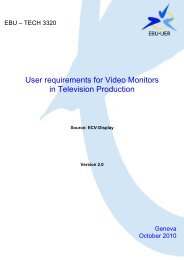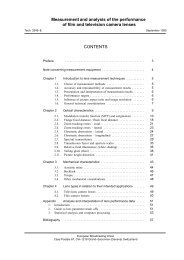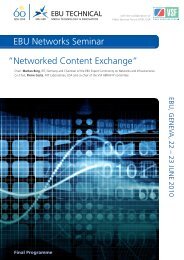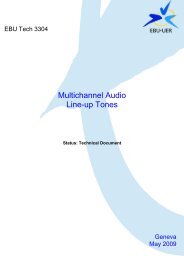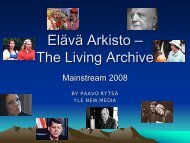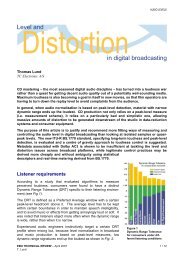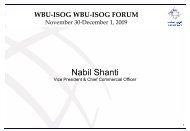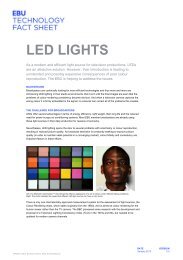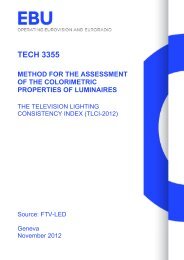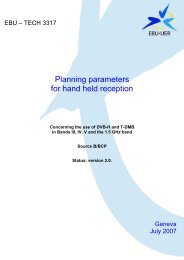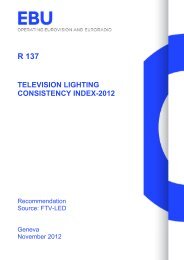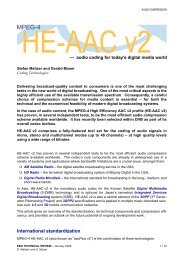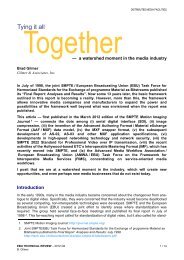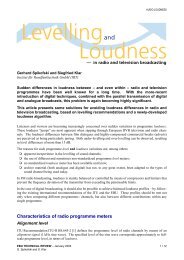Production Technology Seminar 2009 - EBU Technical
Production Technology Seminar 2009 - EBU Technical
Production Technology Seminar 2009 - EBU Technical
Create successful ePaper yourself
Turn your PDF publications into a flip-book with our unique Google optimized e-Paper software.
53<br />
easily zap across the channels and with the remote control respond to requests and messages from the<br />
ORF production team.<br />
The interactivity took place in all levels of production and consumption [18].<br />
� On the viewer side with: of course his/her remote control, the mini EPG [13]+[16], his/her responses<br />
to Voting [20] and to Switch [20], and by 'Skyping' with the production team.<br />
� On the production side:<br />
o A 'Feedback Application' interface displaying the use of the channels [35] and the viewers'<br />
responses [36].<br />
o A 'Recommender tool' [40]-[41], a search & retrieval tool based on the information provided by<br />
the system.<br />
o The producer making informed decisions about which sports to broadcast live or which content of<br />
high interest to repeat. Patterns began to form in the voting and rating of content that indicated high<br />
interest in the behind the scenes action of sports events, this also included the behind the scenes of<br />
the production broadcast itself [15]. The result was the production of new content „on-the-fly‟ such as<br />
studio guest interviews, documentaries about sports personalities and interviews with the production<br />
team [14] or visits to viewers [15].<br />
o Moderators on a dedicated channel for permanent, informal and spontaneous live moderation. It<br />
soon took on the form of a home channel where viewers would return either for a break from the<br />
action or for an update on the action across the 5 channels [22] or to hear what the other viewers had<br />
to say. The producer also relied on the studio channel for immediate reaction to patterns in viewer<br />
behaviour such as a major switch to the medal ceremony involving an Austrian athlete.<br />
The core of the system was an 'Intelligent Media Framework' using an 'Intelligent Content Model' [26]<br />
which integrated the knowledge about the content sources (live events, production archives), the staging<br />
concepts (When do we switch - In which way? - How do we communicate? – Do we treat the main topic<br />
now on the 4 channels? Do we spread our topics?) and the information coming from the supporting tools.<br />
For generating metadata the Fraunhofer Institute developed a 'Human annotation' interface [42].<br />
Results of the field trial 47 . LIVE was “on air” for a total of 33 hours per channel, in which a total of 254<br />
onscreen interactive elements were produced. On average more than half of all viewers took regular<br />
advantage of the interactive elements to switch to dramatic events on another channel or to vote or rate<br />
the content on screen. 87% of viewers participated in the trial on at least two weekends. Overall<br />
satisfaction with the broadcast was very high. In fact 63% of viewers who participated on all three<br />
weekends were very happy with the broadcast [61]. Nearly all of the respondents in the follow-up user<br />
survey indicated that they would like to use such an interactive TV service in the future.<br />
47 http://www.ist-live.org/promo-material/promo-material/trialfolder_s.pdf<br />
© <strong>EBU</strong> <strong>2009</strong> / <strong>Production</strong> <strong>Technology</strong> seminar / January 27 - 29, <strong>2009</strong><br />
Reproduction prohibited without written permission of <strong>EBU</strong> TECHNICAL & <strong>EBU</strong> TRAINING



